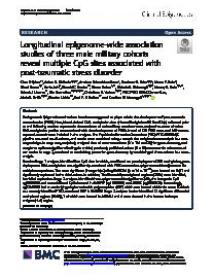Longitudinal epigenome-wide association studies of three male military cohorts reveal multiple CpG sites associated with post-traumatic stress disorder
Background: Epigenetic mechanisms have been suggested to play a role in the development of post-traumatic stress disorder (PTSD). Here, blood-derived DNA methylation data (HumanMethylation450 BeadChip) collected prior to and following combat exposure in three cohorts of male military members were analyzed to assess whether DNA methylation profiles are associated with the development of PTSD. A total of 123 PTSD cases and 143 traumaexposed controls were included in the analyses. The Psychiatric Genomics Consortium (PGC) PTSD EWAS QC pipeline was used on all cohorts, and results were combined using a sample size weighted meta-analysis in a twostage design. In stage one, we jointly analyzed data of two new cohorts (N = 126 and 78) for gene discovery, and sought to replicate significant findings in a third, previously published cohort (N = 62) to assess the robustness of our results. In stage 2, we aimed at maximizing power for gene discovery by combining all three cohorts in a metaanalysis.
Results: Stage 1 analyses identified four CpG sites in which, conditional on pre-deployment DNA methylation, postdeployment DNA methylation was significantly associated with PTSD status after epigenome-wide adjustment for multiple comparisons. The most significant (intergenic) CpG cg05656210 (p = 1.0 × 10−08) was located on 5q31 and significantly replicated in the third cohort. In addition, 19 differentially methylated regions (DMRs) were identified, but failed replication. Stage 2 analyses identified three epigenome-wide significant CpGs, the intergenic CpG cg05656210 and two additional CpGs located in MAD1L1 (cg12169700) and HEXDC (cg20756026). Interestingly, cg12169700 had an underlying single nucleotide polymorphism (SNP) which was located within the same LD block as a recently identified PTSD-associated SNP in MAD1L1. Stage 2 analyses further identified 12 significant differential methylated regions (DMRs), 1 of which was located in MAD1L1 and 4 were situated in the human leukocyte antigen (HLA) region.
Conclusions: This study suggests that the development of combat-related PTSD is associated with distinct methylation patterns in several genomic positions and regions. Our most prominent findings suggest the involvement of the immune system through the HLA region and HEXDC, and MAD1L1 which was previously associated with PTSD.
Geachte bezoeker,
De informatie die u nu opvraagt, kan door psychotraumanet niet aan u worden getoond. Dit kan verschillende redenen hebben,
waarvan (bescherming van het) auteursrecht de meeste voorkomende is. Wanneer het mogelijk is om u door te verwijzen naar de bron
van deze informatie, dan ziet u hier onder een link naar die plek.
Als er geen link staat, kunt u contact opnemen met de bibliotheek,
die u verder op weg kan helpen.
Met vriendelijke groet,
Het psychotraumanet-team.
In: Clinical Epigenetics ISSN: 1868-7083 | 12 | 11
https://clinicalepigeneticsjournal.biomedcentral.com/articles/10.1186/s13148-019-0798-7


